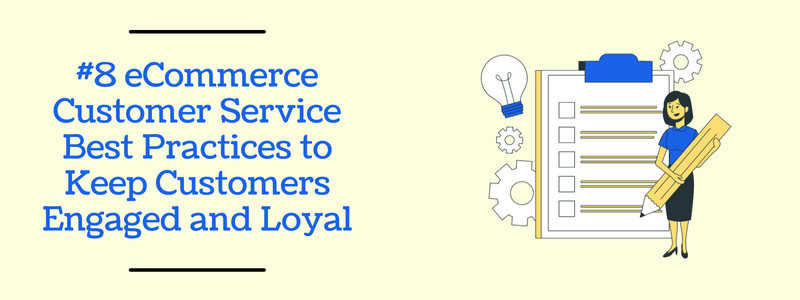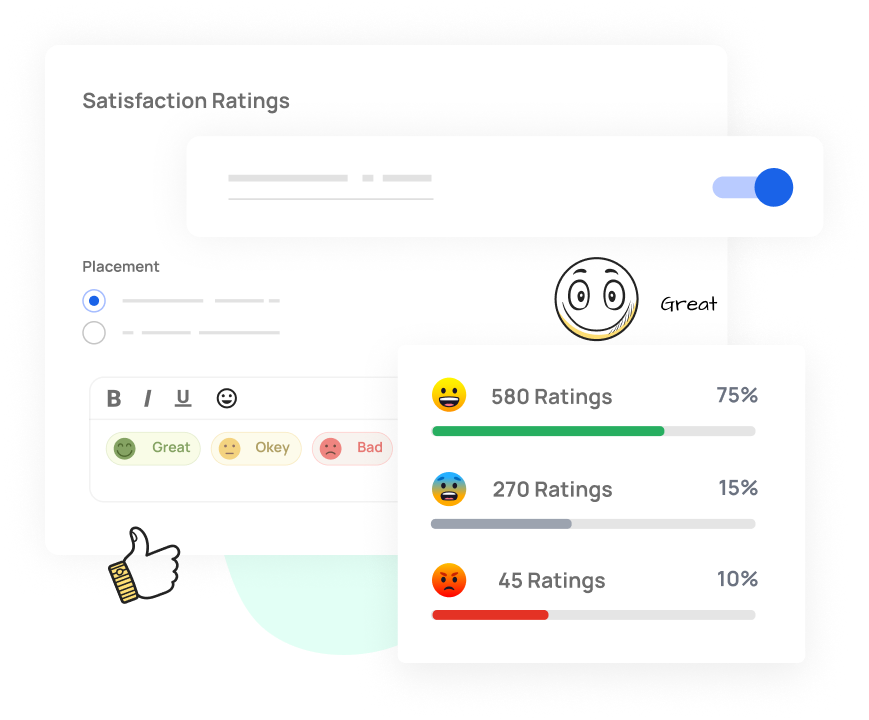If you own an eCommerce site, there is primarily only one source of revenue for you; customers. More customers mean more sales, and more sales mean more profit.
But how do you keep these streamlined sales while keeping your customers satisfied? And how to distinguish yourself from your competitors?
One easy and effective way is by providing great customer service, indeed!
Customer service is the backbone of any eCommerce business. It is important to provide quality customer service to your customers. This ensures that they don’t leave your website and go to a competitor’s website. Disloyal customers are any eCommerce business’s worst nightmare.
In this read, we will discuss eCommerce customer service best practices. These best practices are designed to help you provide the best customer service possible and keep your customers coming back for more!
We have arranged all the essential practices for you to satisfy your customer fully.
Lets dig right in, shall we?
What is eCommerce customer service?
Ecommerce customer service is how businesses assist clients that shop online through a mobile or online store. When a customer has a question or a problem with your product or service, the customer support team steps in and assists them in finding answers. This service is provided by using an omnichannel or multichannel strategy such as CRM, customer service software, helpdesk, live chat, shared inbox, and so on.
Social media, phone, email, live chat, and other communication channels are common for eCommerce assistance. Along with human customer care representatives, businesses may provide automated solutions such as chatbots or automated emails. Many businesses also provide other materials such as FAQs and help guides.
In order to create a seamless customer experience across all touch points, eCommerce customer service refers to assisting online customers with everything from making more thoughtful purchasing selections to resolving concerns.
E-commerce customer service can assist you in the following areas:
- Customer service issues include difficulties completing the checkout process, inability to add things to the cart, invalid coupons, etc.
- Various queries about the quality of the product,color, quantity etc.
- Frequently Asked Questions about Product Returns, Refunds, and Delivery
- The requirement to provide a consistent user experience across numerous communication channels
[elementor-template id=”17208″]
Why Customer Service Matters for eCommerce?
eCommerce customer service becomes increasingly vital as more and more people begin doing their shopping online. And so a boost in volume inevitably creates a demand for more customer service assistance.
According to research, 73% of consumers say customer experience influences their purchasing decisions, and 42% are willing to pay more for a more welcoming and courteous service. Here, poor customer experiences drive clients away faster, diminishing your retention rate.
Excellent eCommerce customer service is also crucial to a company’s brand reputation and present and future sales. A disappointed customer may also submit a negative customer review or use a social platform to warn potential customers about their terrible experience, further complicating matters for your business.
Following are the main reasons why customer service is crucial in e-commerce:
- Boost sales conversions: 83% of online buyers need help placing an order. Customers can make faster sales decisions if you provide real-time support via live chat or by employing an eCommerce bot.
- Increase customer retention: Retaining an existing customer costs seven times less than acquiring a new one. You may enhance client retention by providing timely customer service and resolving customer problems in real-time.
- Promote customer loyalty: A well-executed customer service plan can assist in retaining existing customers, acquiring new customers, reducing turnover, improving customer loyalty, and boosting revenues.
#8 eCommerce Customer Service Best Practices to Keep Customers Engaged and Loyal

Customer service is one of the most important aspects of eCommerce. Here, the customer support team works as a bridge between customers and eCommerce stores. They are responsible for maintaining a high level of engagement with customers and retaining them as loyal shoppers. Also, they need to provide information promptly to ensure the customer has a positive experience.
This section discusses how to provide excellent customer service on eCommerce sites and keep customers engaged and loyal.
Develop a multichannel strategy
According to a survey, organizations with a well-defined omnichannel customer experience had a 91% customer retention rate.
Customers want to see you on the channels they use the most, like your website, social media, email, phone, etc. Here, an omnichannel approach is one of the best options.
The multi-channel approach strives to maximize the strength of multiple channels and improve the customer shopping experience. Additionally, it forges a connection between consumers and brands. The appropriate channel and strategy can help you strengthen your brand in the always-evolving world of eCommerce, and steadiness will help you achieve long-term success.
Creating a multichannel approach necessitates knowing where your customers are, whether it’s Facebook, Instagram, WhatsApp, or Live Chat, and being present. Across all of your channel channels, you should strive to offer a consistently high level of customer service.
To provide the most seamless customer experience possible, you should concentrate on three key components when developing an omnichannel customer support strategy.
- Determine the consumer touchpoints they like.
- Understand your customer’s journey and develop a strategy to engage them.
- Maintain a consistent client experience throughout their customer journey.
For every eCommerce business, the aim should be to provide excellent customer service and make your customers happy.
Maintain consistent customer service
Customer service is crucial no matter what your business is. According to research, 81% of customers say that excellent customer service makes them more likely to buy from that company again. 95% of all customers think that excellent customer service is essential to their loyalty to a brand.
When a consumer has an initial positive engagement with your company, it is natural to expect the same level of service in subsequent interactions.
Customers demand consistent customer service across all communication channels, so they are not confused about the conversation’s outcome. Also, customer service must be of the highest caliber when it matters most and is most urgent, such as a sale.
Consistent customer service is essential for the following reasons:
- It assists in lowering the typical response time.
- It contributes to a high first contact resolution (FCR) rate.
- It helps in gaining a deeper understanding of the consumer profiles and journey.
How should e-commerce performance be measured?
- Determine the best e-commerce key performance indicators (KPIs) and track/measure their associated metrics.
- Ensure that you have an analytics system to measure these metrics as accurately as possible.
- Set the proper benchmarks for your e-commerce KPIs as a success indicator.
Implement Live Chat to deliver real-time support
Live chat is the most popular customer service channel due to its instant activity. According to research, 79% of clients choose live chat over other channels due to its immediacy. Studies indicate that adding Live Chat on your site can lead to 3-5 times more conversions, which helps to enhance sales.
Instead of waiting 24 hours or longer for a response to an email, clients can (in the majority of cases) obtain a reply instantly with live chat software. Faster response times enhance client loyalty and satisfaction. Also, customers are less likely to leave your website without making a purchase when you can promptly respond to their inquiries and concerns.
The main distinctions between live chat and other channels are:
- Live chat allows you to communicate with customers in real time. Identifying the problem’s complexity aids in its resolution during the initial interaction.
- Live chat allows operators to handle many conversations at the same time, which enhances efficiency. It also offers a variety of choices for chat distribution and consumption.
- Messaging is the most popular channel – Customers prefer to communicate with assistance via messaging.
Automate your customer service process with Help Desk Software
A unified help desk is one of the most crucial features of an eCommerce customer care platform. Helpdesk software that combines email, live chat, phone, and social media into one platform helps customer service representatives to manage customer inquiries better and respond to them faster. Similar to a shared inbox, an omnichannel platform will automatically bring tickets in from many sources.
As your firm grows and expands into new channels, you will save time hopping between apps or speculating about previous customer contacts. Instead, automate your customer service with a help desk solution.
How to use a help desk to automate your eCommerce Customer Service Process?
- You can automate ticket creation and assignment with the correct help desk technology. This guarantees that all incoming support issues are turned into individual tickets and assigned to the appropriate agents.
- You can spare your agents from typing the same responses over and over by creating thousands of canned responses.
- You can set up automated emails sent to clients after a ticket is addressed. Such emails allow your clients to rate your service and will enable you to collect customer feedback practically instantaneously.
[elementor-template id=”17208″]
Provide self-service-based eCommerce support
A knowledge base assists prospective customers in making informed purchasing decisions by providing comprehensive answers to frequently asked questions. Self-service improves consumer satisfaction after purchase while reducing the amount of support needed.
Instead of speaking with a service representative, they would search the internet or use another kind of self-help. Why? Because internet users genuinely want to help themselves. A study found that 90% of shoppers utilize self-service to find answers.
How do you give self-service eCommerce?
- Chatbots: Even when you or other team members aren’t accessible, you can employ AI bots to have real-time chats with consumers and offer 24/7 service.
- FAQs: You can utilize a chatbot design for an eCommerce carousel or add full FAQ pages that include issues like billing and payments, shipping, returns, and refund policy.
- Knowledge base: You can set up a knowledge base with details about your business, goods, services, or anything else you think clients might find interesting.
Make yourself available to customers on social media
Customers are more active than ever on social media. According to a Microsoft study, 50% of customers between 18 and 34 have contacted a company via social media.
Without social media, no eCommerce customer service strategy is complete. Leading social platforms, like Facebook, Instagram, and Twitter, have evolved into effective tools for assisting existing consumers and attracting new ones.
Encourage your team to monitor what customers say about your business on social media. Resolving their complaints on a public stage will assist your company in developing a solid brand image.
Also, greeting consumers on their birthdays or anniversaries and tagging them can significantly increase client loyalty. You can also hold contests as part of your social media strategy, rewarding winners with unique presents or money-saving vouchers.
Request for feedback and respond to both positive and negative feedback
If you want to improve something, you need to know and measure it to act accordingly. So, how do you do that? Ask for feedback from your customer.
Customer feedback is a critical component of business growth. Feedback provides a clear picture of how well your company is doing. This helps measure customer satisfaction rate and satisfied customers recommend your product with positive feedback and good word of mouth which eventually reduces customer churn.

Responding to all sorts of consumer feedback (both positive and negative) in a constructive, professional ‘brand voice’ can help the brand evolve and positively impact how the public perceives it.
It might be disheartening and demoralizing when people complain, but it’s crucial to remember not to take negative remarks personally. On that note, positive responses and interactions with customers can increase a brand’s ranking and exposure, much like receiving reviews does.
The following are some reasons why customer input is crucial to business:
- Evaluate client satisfaction
- Product and service improvements
- Improve the customer experience
- increase in client retention
- Improve the way you interact with customers
Develop a customer retention strategy
Customer retention is one of the most challenging aspects of an e-commerce firm. Brands using a customer-journey management plan boost their return on marketing investment by 53%.
You can boost client retention by giving a pleasurable, dependable, consistent, and consistent experience. If you want your firm to flourish, you must concentrate on the entire client lifecycle, including nurturing, engaging, and retaining customers.
Here are a few ideas for keeping your consumers:
- Motivate/reward: Rewarding outstanding clients encourages them to stay with your brand for a more extended period of time.
- Loyalty programs: According to a report, 66% of customers modify the amount they spend to maximize points. Implement a loyalty program to reconnect with your existing customers.
- Community building: Customers enjoy being a part of a brand’s community. Customers benefit from community building by creating a good mood and improving brand image.
Wrapping Up
The quality of your customer service significantly impacts the success of your e-commerce business. And so, it is critical to develop a strategy to ensure your customers have a positive purchasing experience with your company.
A great customer service strategy can boost the exposure of your products on your website and the online marketplaces where you sell, resulting in fewer returns and refunds and a healthier funnel.
Start with the appropriate resources to establish a solid foundation. Then, develop the technologies to enable your support team’s resource scalability.





